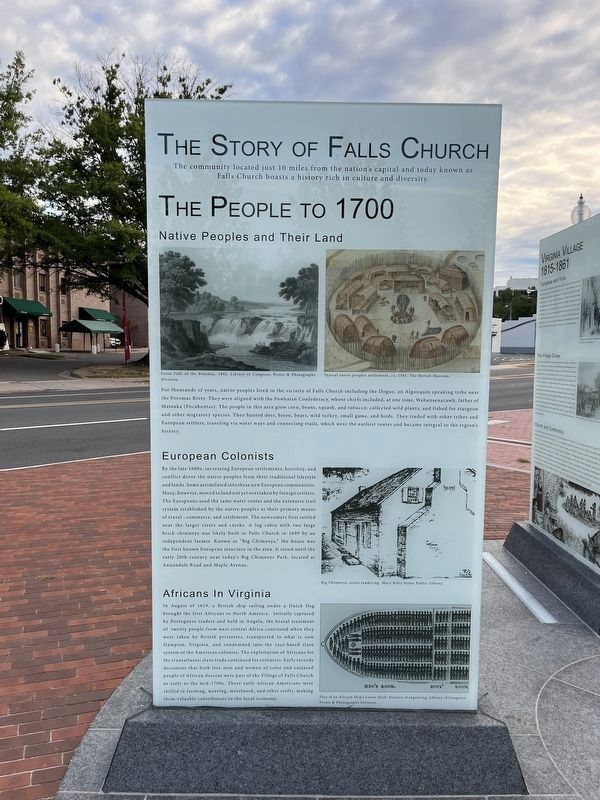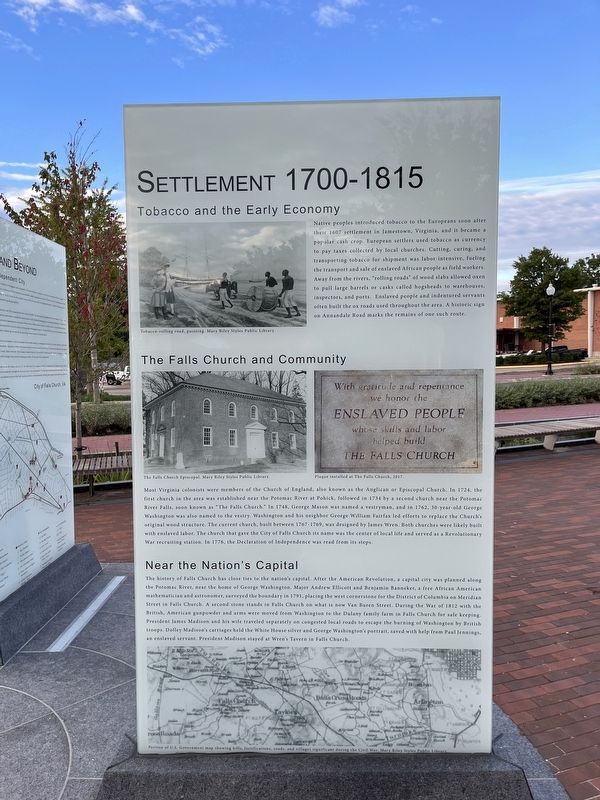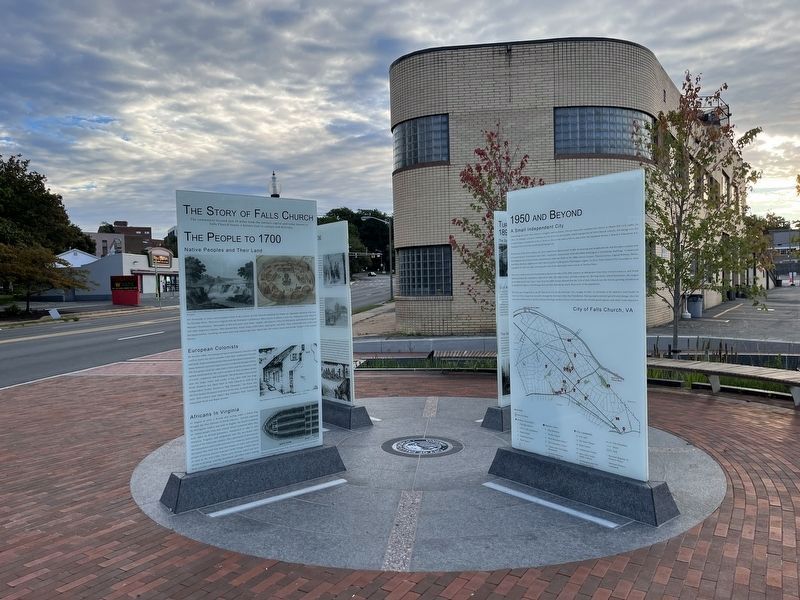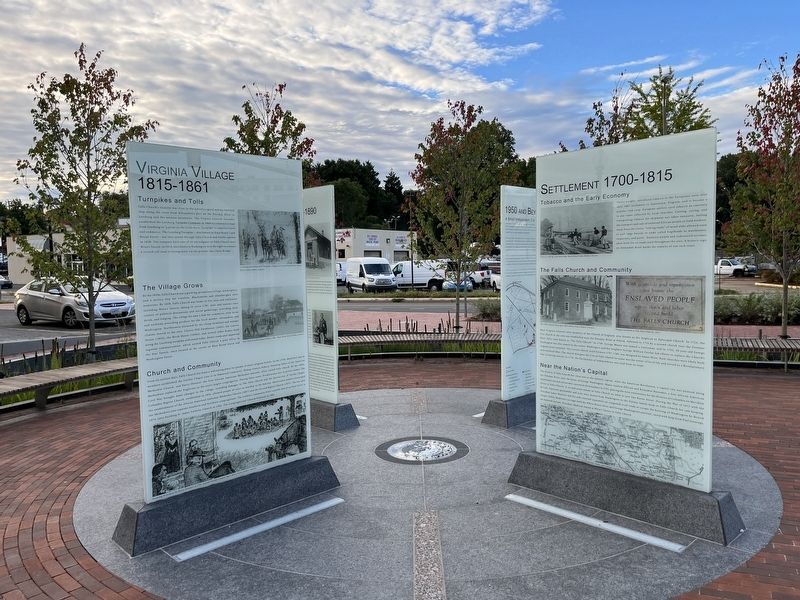Falls Church, Virginia — The American South (Mid-Atlantic)
The Story of Falls Church / Settlement 1700 - 1815

Photographed By Devry Becker Jones (CC0), September 24, 2022
1. The Story of Falls Church side of the marker
The Story of Falls Church
The community located just 10 miles from the nation's capital and today known as Falls Church boasts a history rich in culture and diversity.
The People to 1700
Native Peoples and Their Land
For thousands of years, native peoples lived in the vicinity of Falls Church including the Dogue, an Algonquin speaking tribe near the Potomac River. They were aligned with the Powhatan Confederacy, whose chiefs included, at one time, Wahunsenacawh, father of Matoaka (Pocahontas). The people in this area grew corn, squash, and tobacco; collected wild plants; and fished for sturgeon and migratory species. They hunted deer, bison, bears, wild turkey, small game, and birds. They traded with other tribes and European settlers, traveling via water ways and connecting trails, which were the earliest routes and became integral to the region's history.
European Colonists
By the late 1600s, increasing European settlements, hostility, and conflict drove the native peoples from their traditional lifestyle and lands. Some assimilated into these new European communities. Many, however, moved to land not yet overtaken by foreign settlers. The Europeans used the same water routes and the extensive trail system established by the native peoples as their primary means of travel, commerce, and settlement. The newcomers first settled near the larger rivers and creeks. A log cabin with two large brick chimneys was likely built in Falls Church in 1699 by an independent farmer. Known as "Big Chimneys," the house was the first known European structure in the area. It stood until the early 20th century near today's Big Chimneys Park, located at Annandale Road and Maple Avenue.
Africans in Virginia
In August of 1619, a British ship sailing under a Dutch flag brought the first Africans to North America. Initially captured by Portuguese traders and held in Angola, the brutal treatment of twenty people from west central Africa continued when they were taken by British privateers, transported to what is now Hampton, Virginia, and condemned into the race-based slave system of the American colonies. The exploitation of Africans for the transatlantic slave trade continued for centuries. Early records document that both free men and women of color and enslaved people of African descent were part of the Village of Falls Church as early as the mid-1700s. These early African Americans were skilled in farming, weaving, metalwork, and other crafts, making them valuable contributors to the local community.
Settlement 1700 - 1815
Tobacco and the Early Economy
Native peoples introduced tobacco to the Europeans soon after

Photographed By Devry Becker Jones (CC0), September 24, 2022
2. Settlement 1700 - 1815 side of the marker
The Falls Church and Community
Most Virginia colonists were members of the Church of England, also known as the Anglican or Episcopal Church. In 1724, the first church in the area was established near the Potomac River at Pohick, followed in 1734 by a second church near the Potomac River Falls, soon known as "The Falls Church." In 1748, George Mason was named a vestryman, and in 1762, 30-year-old George Washington was also named to the vestry. Washington and his neighbor George William Fairfax led efforts to replace the Church's original structure. The current church, built between 1767-1769, was designed by James Wren. Both churches were likely built with enslaved labor. The church that gave the City of Falls Church its name was the center

Photographed By Devry Becker Jones (CC0), September 24, 2022
3. The Story of Falls Church side of the marker
Near the Nation's Capital
The history of Falls Church has close ties to the nation's capital. After the American Revolution, a capital city was planned along the Potomac River, near the home of George Washington. Major Andrew Ellicott and Benjamin Banneker, a free African American mathematician and astronomer, surveyed the boundary in 1791, placing the west cornerstone for the District of Columbia on Meridian Street in Falls Church. A second stone stands in Falls Church on what is now Van Buren Street. During the War of 1812 with the British, American gunpowder and arms were moved from Washington to the Dulany family farm in Falls Church for safe keeping. President James Madison and his wife traveled separately on congested local roads to escape the burning of Washington by British troops. Dolley Madison's carriages held the White House silver and George Washington's portrait, saved with the help from Paul Jennings, an enslaved servant. President Madison stayed at Wren's Tavern in Falls Church.
Erected 2022 by City of Falls Church, Virginia.
Topics and series. This historical marker is listed in these topic lists: African Americans

Photographed By Devry Becker Jones (CC0), September 24, 2022
4. Settlement 1700 - 1815 side of the marker
Location. 38° 52.8′ N, 77° 10.476′ W. Marker is in Falls Church, Virginia. Marker is at the intersection of South Washington Street (U.S. 29) and Hillwood Avenue (Virginia Route 338), on the right when traveling north on South Washington Street. Touch for map. Marker is at or near this postal address: 336 S Washington St, Falls Church VA 22046, United States of America. Touch for directions.
Other nearby markers. At least 8 other markers are within walking distance of this marker. The Emerging City 1920 - 1950 / 1950 and Beyond (here, next to this marker); Virginia Village 1815 - 1861 / Civil War 1861 - 1865 (here, next to this marker); Rebuilding 1865 - 1890 / Turn of the 20th Century 1890 - 1920 (here, next to this marker); Home of Mary Ellen Meriwether (Miss Nellie) and Dr. Edwin B. Henderson (EB) (about 400 feet away, measured in a direct line); Sears Kit Home (about 400 feet away); Colored Citizens Protective League (about 400 feet away); Plans to Fight the Ordinance (about 400 feet away); Dr. Edwin Bancroft Henderson (1883-1977) (about 400 feet away). Touch for a list and map of all markers in Falls Church.
Additional keywords. human trafficking
Credits. This page was last revised on May 10, 2023. It was originally submitted on September 24, 2022, by Devry Becker Jones of Washington, District of Columbia. This page has been viewed 164 times since then and 41 times this year. Photos: 1, 2, 3, 4. submitted on September 24, 2022, by Devry Becker Jones of Washington, District of Columbia.